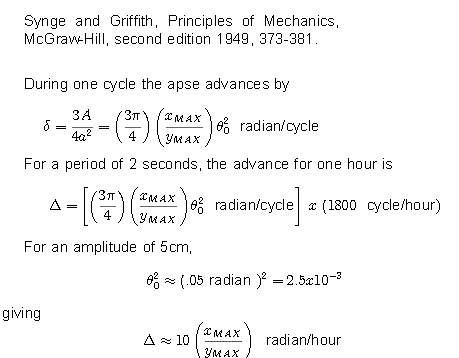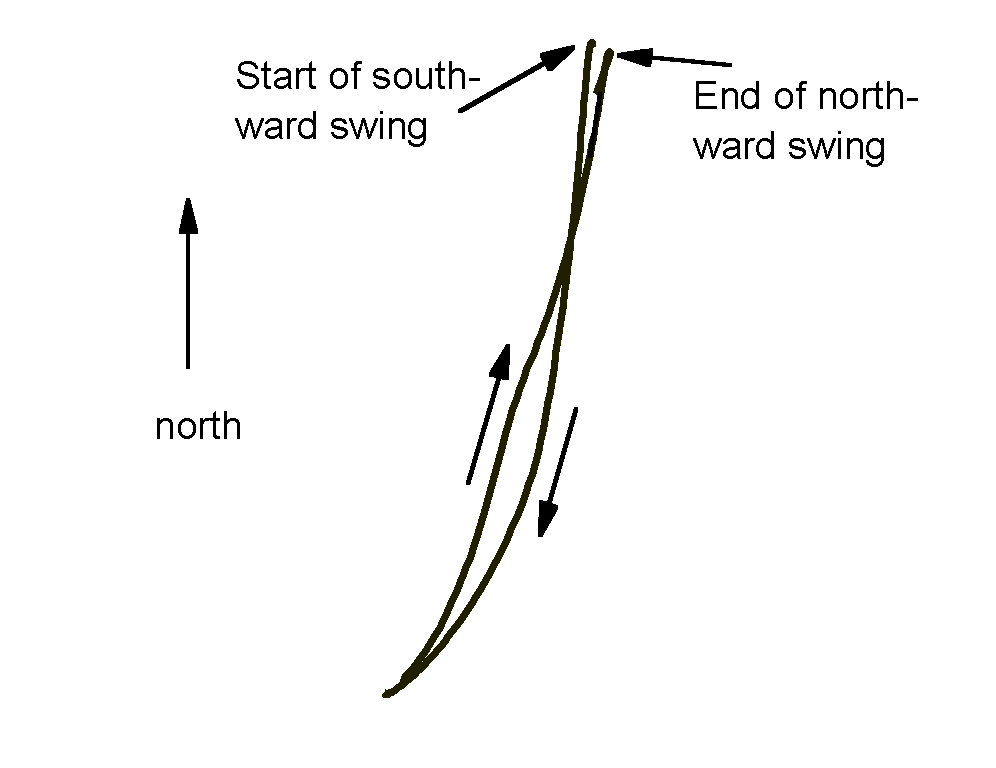Experiment of The Month
The Coriolis Drives a Clockwise Elliptical Precession
Looking down on the pendulum, as in the
The ellipse may be described as the sum of two motions, one along the minor axis of the ellipse and one along the major axis. Ordinarily, the bob displacement along the minor axis is maximum when the bob displacement along the major axis is zero.
In the figure at right, the major axis is along the
Ordinarily, it is assumed that the period of a pendulum is independent of the amplitude of the pendulum motion. In the case of elliptical
Imagine for a moment that the period along the
However, if the x period is shorter, the x motion reaches its maximum velocity sooner. Its average velocity during this 1/4 period is larger, and the bob travels farther during the 1/4 period than it "should." The effect of this extra travel in the
In fact, the period does depend (weakly) on the amplitude of the motion, and the minor axis does have a shorter period. If the bob follows a clockwise path around the ellipse, the ellipse will precess clockwise. The larger the difference in periods, the larger is the rate of precession. To minimize this effect, in monumental Foucault pendulums, the amplitudes are kept small.
Synge and Griffith worked out the rate of precession for their mechanics book. (Synge and Griffith, Principles of Mechanics, McGraw-Hill, second edition 1949, 373-381)
Their
The ordinary Foucault pendulum at our latitude (about 40 degrees north) "should"
The bob can follow an elliptical path in either the clockwise or the counterclockwise direction, leading to precession either in the direction of the Foucault
Our method of driving pumps energy into the major axis
On the other hand, in the presence of a Coriolis force, our method of driving causes a clockwise precession. A sketch of how the Coriolis force associated with the vertical driving velocity induces clockwise precession follows:
At mid-latitudes, when
When the same bob swings south, pulling the bob up causes the bob to move (more nearly) perpendicular to the earth's axis. The Coriolis force is increased.
In the extreme case, the northward path is straight, with no Foucault precession, while the southward path is curved, with an enhanced Foucault precession. This cyclic path has an elliptical component, with clockwise elliptical trajectory.
The piston driven pendulum will precess clockwise more rapidly than the Foucault pendulum, because of the additional elliptical precession, driven by the Coriolis force on the vertical pumping motion.
In the figure at the right, the path of the bob is calculated for one cycle, 2 seconds in duration, as the bob swings first south, and then north. The drive is a
In the figure, the
To make the effect easier to see, it has been exaggerated by stretching the picture along the


